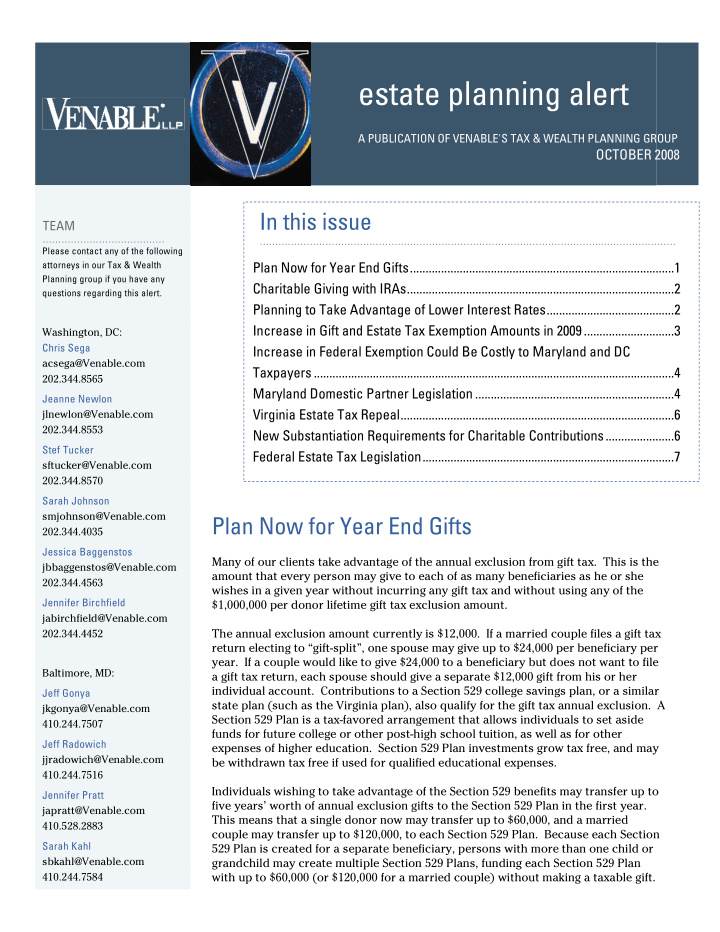



estate planning alert A PUBLICATION OF VENABLE'S TAX & WEALTH PLANNING GROUP OCTOBER 2008 In this issue TEAM ………………………………… ……………………………………………………………………………………………….…………………… Please contact any of the following Plan Now for Year End Gifts.....................................................................................1 attorneys in our Tax & Wealth Planning group if you have any Charitable Giving with IRAs......................................................................................2 questions regarding this alert. Planning to Take Advantage of Lower Interest Rates.........................................2 Increase in Gift and Estate Tax Exemption Amounts in 2009.............................3 Washington, DC: Chris Sega Increase in Federal Exemption Could Be Costly to Maryland and DC acsega@Venable.com Taxpayers ....................................................................................................................4 202.344.8565 Maryland Domestic Partner Legislation ................................................................4 Jeanne Newlon Virginia Estate Tax Repeal........................................................................................6 jlnewlon@Venable.com 202.344.8553 New Substantiation Requirements for Charitable Contributions......................6 Stef Tucker Federal Estate Tax Legislation.................................................................................7 sftucker@Venable.com 202.344.8570 Sarah Johnson smjohnson@Venable.com Plan Now for Year End Gifts 202.344.4035 Jessica Baggenstos Many of our clients take advantage of the annual exclusion from gift tax. This is the jbbaggenstos@Venable.com amount that every person may give to each of as many beneficiaries as he or she 202.344.4563 wishes in a given year without incurring any gift tax and without using any of the Jennifer Birchfield $1,000,000 per donor lifetime gift tax exclusion amount. jabirchfield@Venable.com 202.344.4452 The annual exclusion amount currently is $12,000. If a married couple files a gift tax return electing to “gift-split”, one spouse may give up to $24,000 per beneficiary per year. If a couple would like to give $24,000 to a beneficiary but does not want to file Baltimore, MD: a gift tax return, each spouse should give a separate $12,000 gift from his or her individual account. Contributions to a Section 529 college savings plan, or a similar Jeff Gonya state plan (such as the Virginia plan), also qualify for the gift tax annual exclusion. A jkgonya@Venable.com Section 529 Plan is a tax-favored arrangement that allows individuals to set aside 410.244.7507 funds for future college or other post-high school tuition, as well as for other Jeff Radowich expenses of higher education. Section 529 Plan investments grow tax free, and may jjradowich@Venable.com be withdrawn tax free if used for qualified educational expenses. 410.244.7516 Individuals wishing to take advantage of the Section 529 benefits may transfer up to Jennifer Pratt five years’ worth of annual exclusion gifts to the Section 529 Plan in the first year. japratt@Venable.com This means that a single donor now may transfer up to $60,000, and a married 410.528.2883 couple may transfer up to $120,000, to each Section 529 Plan. Because each Section Sarah Kahl 529 Plan is created for a separate beneficiary, persons with more than one child or sbkahl@Venable.com grandchild may create multiple Section 529 Plans, funding each Section 529 Plan 410.244.7584 with up to $60,000 (or $120,000 for a married couple) without making a taxable gift.
Please note that a donor’s other gifts, such as contributions to irrevocable trusts to Ashley Short cover insurance premiums, may reduce the amount such donor may contribute to a acshort@Venable.com Section 529 Plan without triggering a taxable gift. It is also important to understand 410.244.7751 that, if the donor passes away before the five-year period has expired, a portion of Laura Pacanowsky the gifts will be brought back into the donor’s estate for estate tax computation lpacanowsky@Venable.com purposes. 410.528.2800 Payments for medical expenses and tuition for others (related or unrelated) are not Kelly Moore considered taxable gifts and are not subject to the annual exclusion limits. For ktmoore@Venable.com example, a taxpayer may give a grandchild $12,000 in 2008 and may also pay any 410.244.7445 amount (e.g., $20,000) for that grandchild’s tuition at any level from pre-kindergarten to graduate school without incurring any gift tax. However, in order to be exempt Tysons Corner, VA: from gift tax, payments for medical expenses or tuition must be paid directly to the health care provider or educational institution. (Thus, reimbursement to another Everett Hoeg for such payment is not exempt from gift tax.) “Medical expenses” include the cost ehoeg@Venable.com of medical insurance, including long term care insurance, if paid directly to the 703.760.1908 insurance provider. Lisa Hughes lhughes@Venable.com Charitable Giving with IRAs 703.760.1909 Melissa May In 2006, Congress passed the Pension Protection Act of 2006. Pursuant to Section mamay@Venable.com 1201 of the Act, individuals may utilize funds in their Individual Retirement Accounts 703.760.1654 (IRAs) to make charitable contributions. Although this provision had expired for years after 2007, Congress recently extended Section 1201 to apply to charitable contributions made in 2008 and 2009. Rockville, MD: Laura Quam Typically, most withdrawals from an IRA are subject to Federal income tax. Under llquam@Venable.com the Act, individuals over age 70 1 / 2 may withdraw up to an aggregate of $100,000 per 301.217.5663 year from their IRAs tax free, so long as such amount is contributed to certain qualified tax-exempt organizations before the end of the year of withdrawal. The withdrawal amount may be used to satisfy the individual’s minimum required distribution. Although the charitable contribution is not tax deductible, the amount withdrawn is not included in the IRA participant’s income. This provision offers a significant planning opportunity for individuals over 70 1 / 2 who wish to make charitable contributions in 2008 and 2009. The provision does not apply to withdrawals from qualified retirement plans, such as 401(k) accounts. However, an individual may convert a 401(k) account to an IRA to take advantage of this provision. Please note that this provision now expires on December 31, 2009. Planning to Take Advantage of Lower Interest Rates When interest rates are historically low, as they are now, the potential for success of certain estate planning techniques increases. One such technique is a grantor retained annuity trust (GRAT). A GRAT is an estate planning tool that allows an individual to transfer interests in appreciating assets to an irrevocable trust at a lower transfer tax cost and retain an annuity interest for a specified number of years. At the end of the term, the property remaining passes to the remainder beneficiaries. Because of the retained annuity interest, the value of the gift is “discounted”. 2
Recommend
More recommend